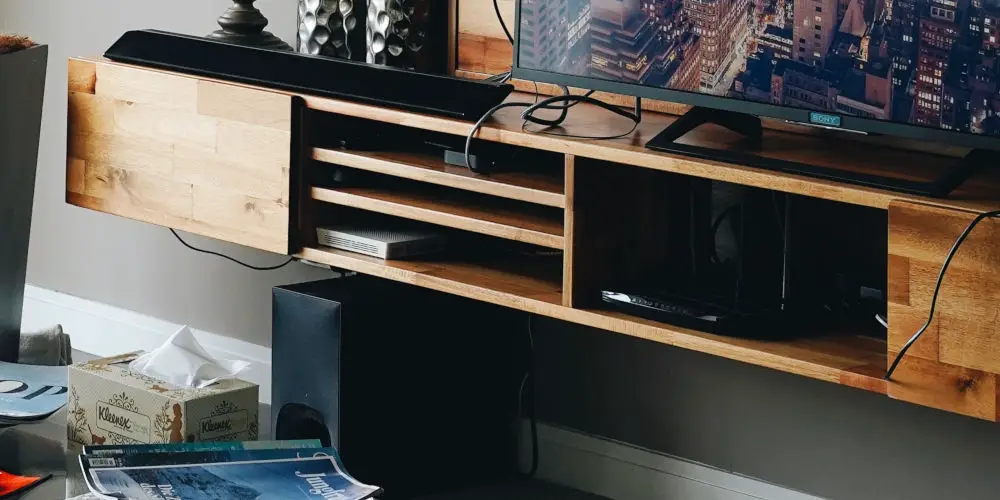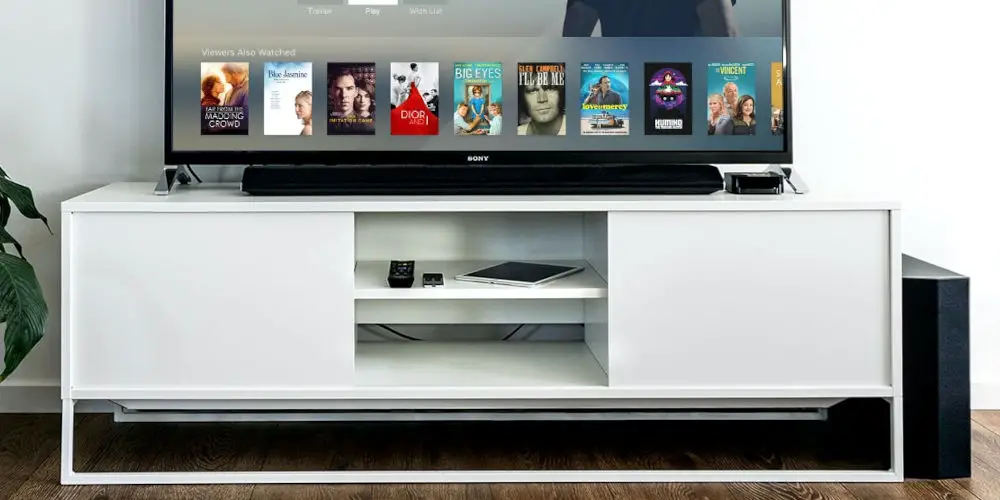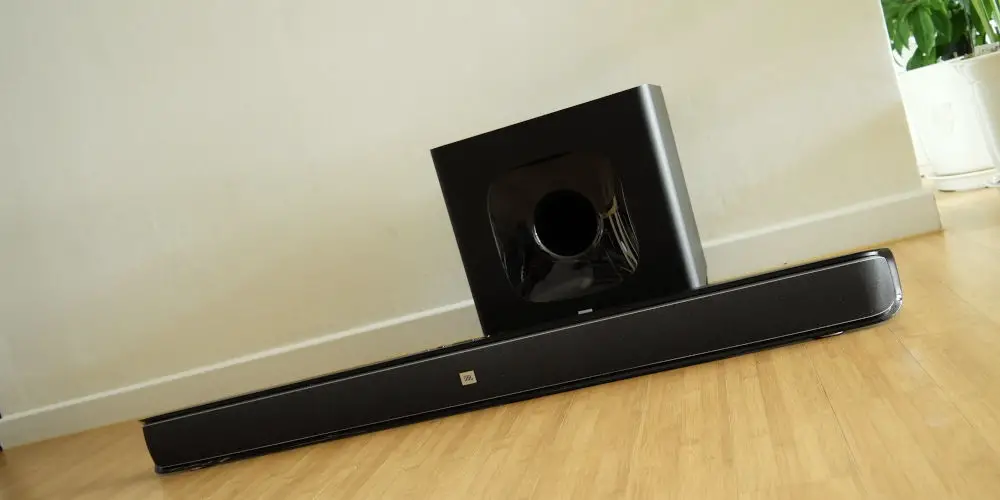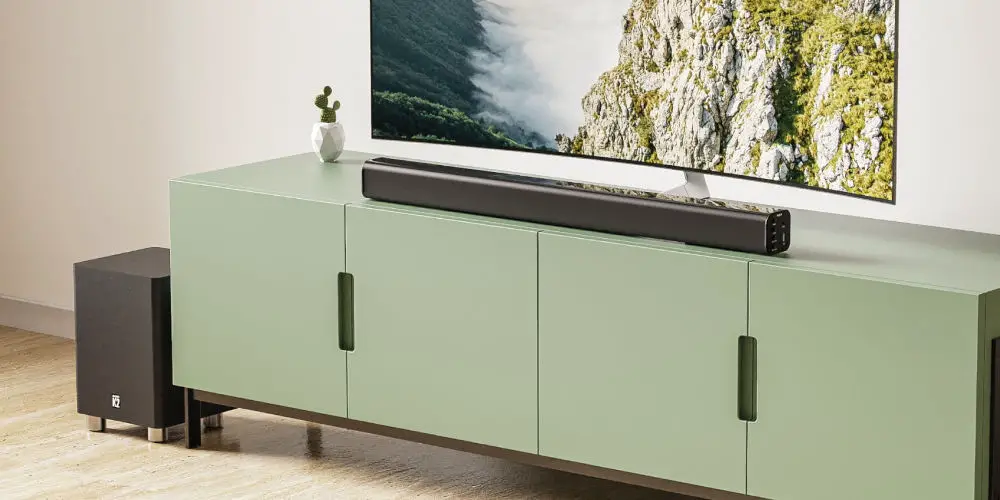What’s the ideal soundbar and subwoofer placement?

The best upgrade you can make to any TV is a soundbar. The second, a subwoofer! Some will buy a soundbar with subwoofer packages. Others will purchase a soundbar with a subwoofer out and then buy a subwoofer. But, what’s the ideal soundbar and subwoofer placement?
Most modern TVs have rear speakers, which result in muffled sound. A soundbar offers an instant improvement as the speakers push sound at you, rather than bouncing off a wall. However, soundbars aren’t great are producing a thumping low end, hence the need for a subwoofer.
Typically, we could place the soundbar above or below the TV. It’s worth trying both positions to assess which sounds best to you. As subwoofers produce large, low frequencies, you can place them in a few different positions as they aren’t as directional as soundbars.
Usually, you’d place the subwoofer below the soundbar, either to the left or right of it. You might even prefer how it sounds when placed directly under the soundbar. But you should try listening to your subwoofer in a few different positions to find the sweet spot.
That said, if you have a wired subwoofer, the cable will be a limiting factor. With a wireless sub, you have more freedom. As long as it’s in range, it will work without fuss.
Let’s explore the ideal soundbar and subwoofer placement based on your equipment, room and best practices.
Making sense of soundbar and subwoofer placement
Where to place your soundbar is fairly straightforward. It’s best either under or above your TV so that the audio matches what’s happening on screen. Of course, you could place the soundbar behind you, but this probably sounds bad as you’ll hear things after they happen on screen.
The ideal subwoofer placement depends largely on personal taste. If you asked two people to position a subwoofer in the same room, they likely would use different spots. They might even place the soundbar differently too.
However, this isn’t the whole picture, as you should also consider room dynamics and your subwoofer’s qualities. These are more nuanced yet have a larger impact. Understanding how to find the ideal soundbar and subwoofer placement will require experimentation.

Why isn’t there one ideal subwoofer placement for soundbars?
Soundbars are highly directional due to the frequencies they handle. Sit to the left or right of a soundbar, and it won’t sound as rich as if you were sitting in front. The lower frequencies a subwoofer handles are large and travel further, so aren’t as directional as those produced by the soundbar.
Typically, you’d place the subwoofer at the front of the room, facing into the room. In this position, the sounds that the subwoofer produces will be in sync with those coming from the soundbar. While this might not be the perfect sounding spot for your subwoofer, it’s a good starting point.
Test around your TV
You can test three different spots at the front of the room. These are to the left of the TV, under it or to the right. In each position, listen to the overall sound as well as how the bass feels. After some experimentation, you’ll find the ideal soundbar and subwoofer placement for your room.
Put it in the corner!
You might find that placing your subwoofer in a corner at the front of the room is the ideal placement. By placing your sub in the corner, you can enhance the sound as the frequencies will also bounce off the wall.
Don’t place your sub directly against the wall as this will result in a muffled sound. Instead, position it at least six inches from the wall, giving it space to breathe and produce a full sound.
Don’t hide it in a cabinet!
If you have a cabinet below your TV that houses your Blu-ray player, set-top box and Blu-ray collection, you might be tempted to squeeze your subwoofer in there as well, especially if you prefer a more minimalist look.
However, this isn’t a good idea as your sub won’t sound as rich as this extra layer of wood will slightly muffle the sound. If you want to hide it away, you’ll want to use a cabinet that’s designed to handle rattles and resonances of low frequencies.

Your room’s acoustics
How your room naturally responds to different frequencies has a massive impact on your soundbar and subwoofer sound. Many people forget this critical piece of information when buying. They end up disappointed with their purchase as it doesn’t sound as good at home as it did in the shop.
Room size
With a small room, you might be limited to a single soundbar and subwoofer placement that sounds good. Of course, if you have a larger room, you’ll have more options to experiment with, and the lower frequencies will have more space to travel.
Interior style
In a living room, you probably don’t want your subwoofer to stick out too much as it’ll ruin the look and feel. So you might be limited. However, placement is less important in a home cinema room.
Soft furnishings
Another element to consider is soft furnishings. A large sofa and thick curtains absorb more low frequencies than thin blinds. And if your room sounds dead by design or accident, you’ll need to experiment more to ensure your subwoofer’s sweet spot.
Rows of seating
If you have two rows of seating, having your subwoofer under the TV or screen might not be the best option as the people and seats in the front row will dampen the bass frequency. The audio might sound lifeless to people in the second row, which is avoidable.
After experimenting, you might decide that the left front corner offers the best bass sound as the subwoofer has space to push air into the room, providing an even sounding low end to all seats. Again, test this by sitting in different seats and listening to your subwoofer sounds in that spot.
Test
For the best soundbar and subwoofer placement, you will want to spend time testing and experimenting with different positions and using your ears to find the sweet spot.

photo by Majority
Wireless vs wired subwoofer
A wireless subwoofer is more flexible than a wired one as you have no cables. So you might be limited from the start if you have a wired unit.
With a wireless subwoofer, you can experiment with its placement as they usually have a range of around 10 metres. So it’s worth listening to different spots, including on the floor, on a shelf, and behind the sofa.
Positioning multiple subwoofers
Having multiple subwoofers in a living room will be overkill. However, in a large home cinema room with two rows of seats, having two subs will ensure a full low end that permeates throughout the room. Start by placing them in the two front corners and experiment from there.
Can I add more speakers to my soundbar and subwoofer?
If you desire surround sound for watching movies, you might wonder how to achieve this using your soundbar and subwoofer. Some soundbars work with wireless rear speakers, allowing you to upgrade from a 2.1 or 3.1 channel system to a 5.1 channel system.
Having rear speakers truly brings movies to life, and the combined system is another step up from just a soundbar and subwoofer. If your current soundbar isn’t expandable, start by upgrading it to one that is, such as the Bose Smart Soundbar 300 or the Samsung HW-Q60T soundbar.
From there, you can add to your new soundbar when you have the budget and build a 5.1 surround sound system that is excellent.




